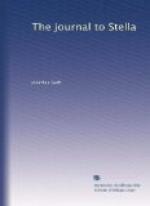8 Scott added a new incident which has become incorporated in the popular conception of Swift’s story. Delany is said to have met Swift rushing out of Archbishop King’s study, with a countenance of distraction, immediately after the wedding. King, who was in tears, said, “You have just met the most unhappy man on earth; but on the subject of his wretchedness you must never ask a question.” Will it be believed that Scott—who rejects Delany’s inference from this alleged incident—had no better authority for it than “a friend of his (Delany’s) relict”?
9 This incident, for which there is probably some foundation of fact—we cannot say how much—has been greatly expanded by Mrs. Woods in her novel Esther Vanhomrigh. Unfortunately most of her readers cannot, of course, judge exactly how far her story is a work of imagination.
10 In October Swift explained that he had been in the country “partly to see a lady of my old acquaintance, who was extremely ill” (Unpublished Letters of Dean Swift, p. 198).
11 There is a story that shortly before her death Swift begged Stella to allow herself to be publicly announced as his wife, but that she replied that it was then too late. The versions given by Delany and Theophilus Swift differ considerably, while Sheridan alters the whole thing by representing Swift as brutally refusing to comply with Stella’s last wishes.
12 There has also been the absurd suggestion that the impediment was Swift’s knowledge that both he and Stella were the illegitimate children of Sir William Temple—a theory which is absolutely disproved by known facts.
13 It is curious to note the intimate knowledge of some of Swift’s peculiarities which was possessed by the hostile writer of a pamphlet called A Hue and Cry after Dr. S—–t, published in 1714. That piece consists, for the most part, of extracts from a supposed Diary by Swift, and contains such passages as these: “Friday. Go to the Club . . . Am treated. Expenses one shilling.” “Saturday. Bid my servant get all things ready for a journey to the country: mend my breeches; hire a washerwoman, making her allow for old shirts, socks, dabbs and markees, which she bought of me . . . Six coaches of quality, and nine hacks, this day called at my lodgings.” “Thursday. The Earl looked queerly: left him in a huff. Bid him send for me when he was fit for company. . . Spent ten shillings.”
14 The “little language” is marked chiefly by such changes of letters (e.g., l for r, or r for l) as a child makes when learning to speak. The combinations of letters in which Swift indulges are not so easy of interpretation. For himself he uses Pdfr, and sometimes Podefar or Fr (perhaps Poor dear foolish rogue). Stella is Ppt (Poor pretty thing). MD (my dears) usually stands for both Stella and Mrs. Dingley, but sometimes for Stella alone. Mrs. Dingley is indicated by me (Madam Elderly), D, or DD (Dear Dingley). The letters FW may mean Farewell, or Foolish Wenches. Lele seems sometimes to be There, there, and sometimes Truly.




